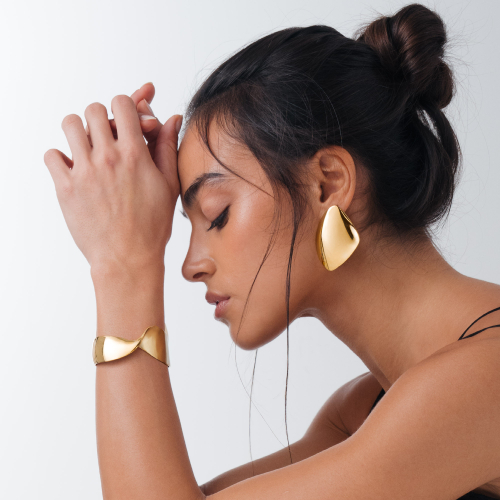
A brief history of natural stones
Since ancient times, man has tried to exploit elements present in nature to express his desire to adorn himself and his surroundings. This is also because driven by the desire to merge with those same elements and draw energy from them, absorb their properties, magical powers and, why not, beauty.
Stones in particular have always enclosed all these characteristics: ancient, pure, generated by a process as mysterious as fascinating.
Chemical bonds, temperature and pressure are the factors that determine some characteristics, but they do not exhaust the thousand facets that make them so precious – and not only in terms of economic value – rare and sought after.
Every stone is born from a gem that in time transforms into something incredible. Perfection is hidden under seemingly irregular shapes. The colors and the various degrees of transparency are generated by chemical reactions which are activated by light; the beam of white light penetrates inside the stone bringing with it electromagnetic waves of all the colors of the visible spectrum and is absorbed in an ever changing way. Each affected element absorbs certain colors and releases others.
This is why this characteristic is fundamental to judge a stone, besides of course its purity and rarity.
Use of stones in jewelry
In jewelry using stones is a practice that dates back to thousands of years ago, even though processing techniques have gradually evolved and today allow the realization of creations that are more and more similar to real works of art.
To work a stone means first of all to cut it; that means to intervene on a raw stone and to cut it in order to give it a precise shape, to highlight its most fascinating characteristics, to exalt its brightness and colors and to make it perfect for the use that one wants to do.
Obviously the shapes that stones can take are many, different for every type and use. What they have in common is the faceting, which is exactly the intervention that gives light and brilliance to the worked element, going to create reflections individually imperceptible but in unison of great effect at every movement.

Even steel goes with stones
The use of stones – be they precious, hard, natural – is most easily taken into consideration when thinking of a combination with precious materials, gold and silver above all. How can we not immediately think of a wonderful solitaire set in a gold frame? Or, without bothering the rare and precious diamond, is it not immediate to fly with the mind to exotic silver jewelry made even more unique and desirable by the presence of bright turquoise or mysterious agate? However, it is not certain that other materials cannot also enhance and be enhanced in turn by the combination of stones. This is the case of Breil jewelry, all made of steel to be faithful to the DNA of the brand. Steel ennobled by a refined design, always one step ahead of the others. But also by an always different and innovative workmanship, aimed at emphasizing lines and shapes. The stones used by Breil to enrich and make its jewelry collections more and more surprising are mainly natural. They are chosen on the basis of the characteristics of hardness, color, luster and possibility of being worked. This is because the design component plays a fundamental role in the brand’s proposal and concerns every single element that makes up the product, including the stones.
Breil collections with stones
Since the birth of its jewelry line, Breil has combined the material of choice for its creations, steel, with semi-precious stones. Initially, these were large quartz stones in pastel shades of pink or yellow, skilfully faceted and set in huge signet rings that adorned women’s hands. Then, little by little, the experiments were multiple and original, in shapes as well as in design. Until you get to the current catalog, full of proposals in which the contamination between steel and stones becomes increasingly effective and interesting. And so green light to the use of zircons, agates and quartz carved and set by hand in the elements that make Breil Stones jewelry unique and always different. But there are also collections in which shine, small and yet precious, multifaceted natural diamonds: unexpectedly, these collections are dedicated to the male universe. Black Diamond is not for everyone, but certainly for those who appreciate the details that make the difference.
Always the man has available a series of bracelets with a distinctly ethnic taste, characterized by the use of stones that have been selected not only for their aesthetics, but also and above all, for the various magical properties:
- blue sodalite, which is the stone of knowledge and truth, which has relaxing properties and allows you to free your mind from accumulating thoughts
- red jasper, which rekindles passion, stimulates creativity and helps you connect with the earth
- hematite, which balances the body’s energies and stimulates the mind, promoting concentration
- shungite, which has special physical, chemical and bioenergetic properties, is able to harmonize and regulate the energy field of the organism and especially to normalize the nervous processes, helping to overcome moments of intense psycho-physical stress

In other cases, stones represent a purely aesthetic choice, as in the case of Beat bracelets:
- the steel in the classic silver color has been combined with lapis lazuli, the ancient stone of the pharaohs, with its thousands of blue shades and sober elegance
- steel in IP black has been combined with tiger’s eye in a warm brown color

A surprising choice was also made in proposing a collection of women’s watches, with a retro flavor: B-Rock is designed to be as original as it is comfortable. The steel bangle is flexible and easy to wear. The dial is made super glam by the use of blue lapis lazuli or green malachite. A truly unusual choice.



